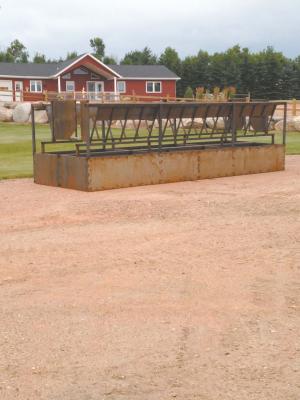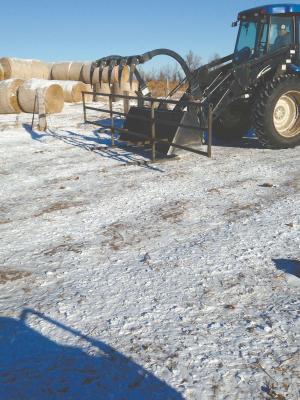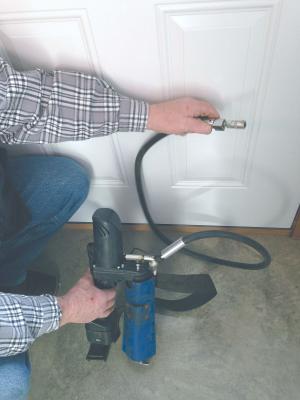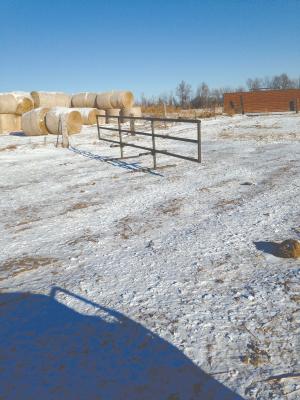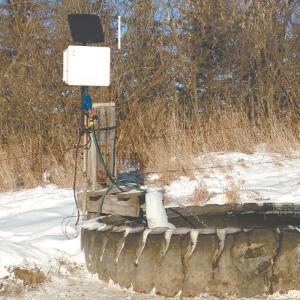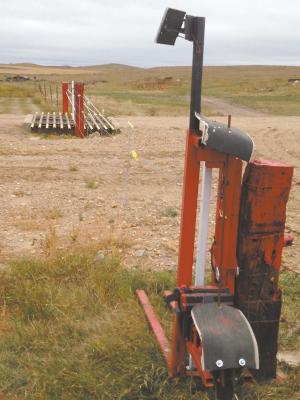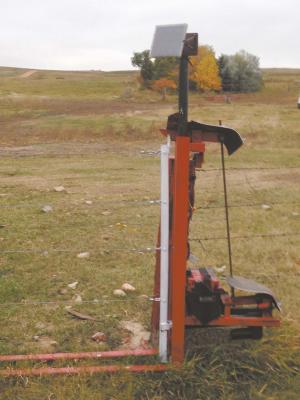Innovative Ideas Make Ranching Easier, More Profitable
Saving time and effort is vital for Dick Schirado as he manages 5,000 acres of crop and range land with more than 400 head of cows, calves and replacement heifers. The North Dakotan has come up with a number of ways to be more efficient. Some are for sale, while others are do-it-yourself time and money savers.
“I mostly work on these things in my shop in the winter,” says Schirado. “I’m always looking for ways to do things faster and easier. My remote control gates and hydrants, as well as lift gates, let me feed and water 400 head of cattle without getting out of my tractor cab.”
The inventor and fabricator has turned his ideas into a business, Schirado Inventions. While he currently makes and sells several of his inventions, he would prefer to license them to a manufacturer. Currently he is looking for licensees for all but his one-handed grease gun.
Contact: FARM SHOW Followup, Schirado Inventions, 6275 31st St., Glen Ullin, N. Dak. 58631 (ph 701 471-5370; inventions@schiradoinventions.com; www.schiradoinventions.com).
One-Handed Grease Gun
Shirado started working on his grease gun idea about 10 years ago and talked to a number of manufacturers, but no one was interested.
“Greasing is always a job you put off,” says Schirado. “I wanted to make it easier with a longer hose to reach out to a zerk with one hand and trigger the gun by a switch on the end of the hose.”
Schirado started by making a crude prototype with a used light switch to trigger an electric grease gun. Once he proved the concept, he redesigned it with a switch he developed and fabricated. “I redesigned the wiring with a relay to handle the long wire needed. I’ve had my prototype working on the farm for almost 2 years, and it has stood up well.”
Later this fall a Canadian manufacturer, Dynaline Industries, will be introducing the new design as a complete electric grease gun, not a kit. It has a 54-in. hose to roughly match the length of the average person’s arm length. The gun can be laid on the ground or slipped into a holster that holds the entire cartridge barrel to protect the user’s clothes.
“With the long hose and the switch at the end of it, you can hold the hose in one hand and hold a trouble light or flashlight in the other,” says Schirado. “If preferred, you can bypass the switch on the end of the hose and use the standard trigger.”
Remote-Controlled Water Hydrant
Schirado no longer worries about ice-covered water tanks or frozen hoses and hydrants. All he has in his cattle yard is a large tractor tire tank and water hydrant. His remote controlled water hydrant lets him turn the water on or off as needed.
“I had an idea for what I wanted and contacted a prototyping company to help with design,” says Schirado. “I have a patent pending, and now I’m looking for someone to license and build it.”
What Schirado came up with is a simple kit that can be attached to a standard water hydrant. After removing the handle, brackets are attached to the hydrant pipe and the pull rod. The brackets hold an electric actuator with a receiver on the switch that can be triggered by a text from his cell phone. The unit texts back the time the water starts to flow.
“I know that an hour and a half after I feed the herd in the winter, they will go for water,” he says. “If I feed at 11 a.m., at 12:30, I turn on the water, whether I’m in my shop or in town.”
After years of working with a similar sized herd, Schirado knows how long the cattle will drink. If he turns the water off in just under two hours, the tank will be nearly empty when the cattle are finished. Even if a couple inches of ice form, it will thaw when the water is next turned on.
“I use a small solar panel for power and a 12-volt battery,” says Schirado. “Just the savings in electricity to heat a tank will pay for the remote unit.”
Schirado is making and selling prototype units for $1,000. However, he is continuing to refine it, with plans to reduce the bulk and cost of the current unit. He says it has more uses than simply watering cattle.
“It could be used to water a lawn or garden when you were on vacation or even fill a sprayer holding tank when you are returning to refill the sprayer,” he says. “In warm weather, you can turn it on and then use a float to shut off a valve at the end of the input hose.”
Schirado expects the remote unit will continue to evolve. “I plan to add a camera for a live view of the water level,” he says.
“I also want to add a built-in timer.”
Remote-Controlled Gate
Why get out of the tractor to open a gate when all you have to do is hit a remote? Schirado’s remote-controlled gate uses a solar-powered linear actuator to hold, release and relatch the gatepost. The gatepost is hinged at ground level. The actuator simply lays the post and its attached cables down on the ground.
“I went with cables instead of wires because wires can follow tractor tires up, but cables just lay there,” says Schirado. “I tried chains, but they are too heavy. With cables, the gates can be up to 50 ft. wide.”
A transmitter/receiver controller lets him use key fobs as controllers. He has multiples for each gate, so he has controllers in every vehicle.
“The linear actuator serves like a lock on the gate. However, there can be some release creep over time, so I incorporated a latch in the linkage that locks it closed,” says Schirado. “It will never open unless activated with a key fob or with the manual switch at the gate.”
The manual override on the gate also allows the gatepost to be completely detached. “It can be opened like a regular gate if you need to blade the road or drag equipment through,” says Schirado.
Schirado makes and sells the gate release kits, which start at $1,000, battery not included. The only variable in the price is the length of cables ordered.
3-in-1 Feed Bunk
Schirado feeds his cattle different rations, but why have different feed bunk styles? His 3-in-1 feed bunk is a freestanding, bottomless bunk for a mixed ration or silage in a pen or pasture. It can also be placed in a fence line. Put two together to hold and feed up to three big round bales. Instead of falling on the ground, leaves and small stems fall into the bunk to be eaten later.
The steel 3-in-1 bunks are 20 ft. long, 4 ft. wide and 26 in. deep. The bale rack serves a dual purpose. When a unit is used for fenceline feeding, it prevents cattle from stepping through or jumping across the bunk. Schirado has single bunk units priced at $1,650.
Loader Lift Gate
This easy-to-make lift gate is not for sale. However, Schirado highly recommends anyone with cattle or horses consider building one.
“I drive up to it with my loader, lift it out of the way with bale forks, drive through and set it back down,” says Schirado. “It’s quicker than climbing in and out of a cab to open a regular gate. That can be important when cattle are headed your way.”
The 22-ft. long, 54-in. high gate can be made from steel pipe, rod or tubular steel. The 4-ft. long feet at the base give it stand-alone stability.
“I set it in place on the pressure side of a pen, and I’ve never had a problem with cattle pushing it aside,” says Schirado. “I added a set of 30-in. long pipes to the gate. They stick out perpendicular to the sides and let me pick it up with a bucket.”
The lift gate works so well when used with Schirado’s ‘prime the herd’ feeding technique that he has them in every hay fence and some feedlots.
“I keep a hay rack near the fence with a hay bale on it,” says Schirado. “Using the lift gate, I can drive through quickly, close the gate and grab the bale off the hay rack. I use it to divert the attention of the cattle while I fill bunks or bring in more hay bales. “

Click here to download page story appeared in.
Click here to read entire issue
Innovative Ideas Make Ranching Easier More Profitable FARM SHOP Tools Saving time and effort is vital for Dick Schirado as he manages 5 000 acres of crop and range land with more than 400 head of cows calves and replacement heifers The North Dakotan has come up with a number of ways to be more efficient Some are for sale while others are do-it-yourself time and money savers “I mostly work on these things in my shop in the winter ” says Schirado “I’m always looking for ways to do things faster and easier My remote control gates and hydrants as well as lift gates let me feed and water 400 head of cattle without getting out of my tractor cab ” The inventor and fabricator has turned his ideas into a business Schirado Inventions While he currently makes and sells several of his inventions he would prefer to license them to a manufacturer Currently he is looking for licensees for all but his one-handed grease gun Contact: FARM SHOW Followup Schirado Inventions 6275 31st St Glen Ullin N Dak 58631 ph 701 471-5370; inventions@schiradoinventions com; www schiradoinventions com One-Handed Grease Gun Shirado started working on his grease gun idea about 10 years ago and talked to a number of manufacturers but no one was interested “Greasing is always a job you put off ” says Schirado “I wanted to make it easier with a longer hose to reach out to a zerk with one hand and trigger the gun by a switch on the end of the hose ” Schirado started by making a crude prototype with a used light switch to trigger an electric grease gun Once he proved the concept he redesigned it with a switch he developed and fabricated “I redesigned the wiring with a relay to handle the long wire needed I’ve had my prototype working on the farm for almost 2 years and it has stood up well ” Later this fall a Canadian manufacturer Dynaline Industries will be introducing the new design as a complete electric grease gun not a kit It has a 54-in hose to roughly match the length of the average person’s arm length The gun can be laid on the ground or slipped into a holster that holds the entire cartridge barrel to protect the user’s clothes “With the long hose and the switch at the end of it you can hold the hose in one hand and hold a trouble light or flashlight in the other ” says Schirado “If preferred you can bypass the switch on the end of the hose and use the standard trigger ” Remote-Controlled Water Hydrant Schirado no longer worries about ice-covered water tanks or frozen hoses and hydrants All he has in his cattle yard is a large tractor tire tank and water hydrant His remote controlled water hydrant lets him turn the water on or off as needed “I had an idea for what I wanted and contacted a prototyping company to help with design ” says Schirado “I have a patent pending and now I’m looking for someone to license and build it ” What Schirado came up with is a simple kit that can be attached to a standard water hydrant After removing the handle brackets are attached to the hydrant pipe and the pull rod The brackets hold an electric actuator with a receiver on the switch that can be triggered by a text from his cell phone The unit texts back the time the water starts to flow “I know that an hour and a half after I feed the herd in the winter they will go for water ” he says “If I feed at 11 a m at 12:30 I turn on the water whether I’m in my shop or in town ” After years of working with a similar sized herd Schirado knows how long the cattle will drink If he turns the water off in just under two hours the tank will be nearly empty when the cattle are finished Even if a couple inches of ice form it will thaw when the water is next turned on “I use a small solar panel for power and a 12-volt battery ” says Schirado “Just the savings in electricity to heat a tank will pay for the remote unit ” Schirado is making and selling prototype units for $1 000 However he is continuing to refine it with plans to reduce the bulk and cost of the current unit He says it has more uses than simply watering cattle “It could be used to water a lawn or garden when you were on vacation or even fill a sprayer holding tank when you are returning to refill the sprayer ” he says “In warm weather you can turn it on and then use a float to shut off a valve at the end of the input hose ” Schirado expects the remote unit will continue to evolve “I plan to add a camera for a live view of the water level ” he says “I also want to add a built-in timer ” Remote-Controlled Gate Why get out of the tractor to open a gate when all you have to do is hit a remote? Schirado’s remote-controlled gate uses a solar-powered linear actuator to hold release and relatch the gatepost The gatepost is hinged at ground level The actuator simply lays the post and its attached cables down on the ground “I went with cables instead of wires because wires can follow tractor tires up but cables just lay there ” says Schirado “I tried chains but they are too heavy With cables the gates can be up to 50 ft wide ” A transmitter/receiver controller lets him use key fobs as controllers He has multiples for each gate so he has controllers in every vehicle “The linear actuator serves like a lock on the gate However there can be some release creep over time so I incorporated a latch in the linkage that locks it closed ” says Schirado “It will never open unless activated with a key fob or with the manual switch at the gate ” The manual override on the gate also allows the gatepost to be completely detached “It can be opened like a regular gate if you need to blade the road or drag equipment through ” says Schirado Schirado makes and sells the gate release kits which start at $1 000 battery not included The only variable in the price is the length of cables ordered 3-in-1 Feed Bunk Schirado feeds his cattle different rations but why have different feed bunk styles? His 3-in-1 feed bunk is a freestanding bottomless bunk for a mixed ration or silage in a pen or pasture It can also be placed in a fence line Put two together to hold and feed up to three big round bales Instead of falling on the ground leaves and small stems fall into the bunk to be eaten later The steel 3-in-1 bunks are 20 ft long 4 ft wide and 26 in deep The bale rack serves a dual purpose When a unit is used for fenceline feeding it prevents cattle from stepping through or jumping across the bunk Schirado has single bunk units priced at $1 650 Loader Lift Gate This easy-to-make lift gate is not for sale However Schirado highly recommends anyone with cattle or horses consider building one “I drive up to it with my loader lift it out of the way with bale forks drive through and set it back down ” says Schirado “It’s quicker than climbing in and out of a cab to open a regular gate That can be important when cattle are headed your way ” The 22-ft long 54-in high gate can be made from steel pipe rod or tubular steel The 4-ft long feet at the base give it stand-alone stability “I set it in place on the pressure side of a pen and I’ve never had a problem with cattle pushing it aside ” says Schirado “I added a set of 30-in long pipes to the gate They stick out perpendicular to the sides and let me pick it up with a bucket ” The lift gate works so well when used with Schirado’s ‘prime the herd’ feeding technique that he has them in every hay fence and some feedlots “I keep a hay rack near the fence with a hay bale on it ” says Schirado “Using the lift gate I can drive through quickly close the gate and grab the bale off the hay rack I use it to divert the attention of the cattle while I fill bunks or bring in more hay bales “
To read the rest of this story, download this issue below or click
here to register with your account number.
